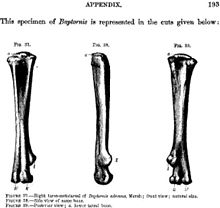Baptornis
| Baptornis | |
|---|---|

| |
| Illustration of a tarsometatarsus, 1880 | |
| Scientific classification | |
| Domain: | Eukaryota |
| Kingdom: | Animalia |
| Phylum: | Chordata |
| Clade: | Dinosauria |
| Clade: | Saurischia |
| Clade: | Theropoda |
| Clade: | Avialae |
| Clade: | †Hesperornithes |
| Family: | †Baptornithidae AOU , 1910
|
| Genus: | †Baptornis Marsh, 1877 |
| Species: | †B. advenus
|
| Binomial name | |
| †Baptornis advenus Marsh, 1877[1]
| |
| Synonyms | |
|
Parascaniornis Lambrecht, 1933 | |
Baptornis ("diving bird") is a
Othniel Charles Marsh discovered the first fossils of this bird in the 1870s. This was, alongside the Archaeopteryx, one of the first Mesozoic birds to become known to science.
Ecology
More material evidence exists for the ecology of B. advenus than for any other member of the Hesperornithes, with the possible exception of Hesperornis regalis, but still much is left to conjecture. The
The waters which it inhabited were fairly shallow
While it was excellently adapted to swimming and diving, Baptornis is thought to have been clumsy on land, pushing itself along the rocks with its feet rather than actually walking. The natural position of the lower legs was flush against the body, with the feet stretched out sideways and thus it would have been unable to move upright without toppling over. As opposed to Hesperornis which almost certainly had to slide on its belly or
The only certain record of Hesperornithes' food found so far comes from Baptornis: Specimen
Systematics
Baptornis was related to the bigger, better known Hesperornis. Both belonged to the Hesperornithes, a group of prehistoric birds which were uniquely adapted to diving and swimming, and had teeth. Otherwise, they were fairly similar to living birds rather than to more dinosaur-like forms such as Archaeopteryx or the Enantiornithes.
As Baptornis was quite peculiar among the Hesperornithes, the
In 2004, it was announced that material of a second species were being prepared for description. This specimen was about twice as massive as the type of B. advenus. The bones had been found in the lower Pierre Shale of SW South Dakota.[3] James Martin and Amanda Cordes-Person named this species Baptornis varneri in 2007, but it was later reclassified as a species of the genus Brodavis and may not have been closely related to B. advenus.[4]
In addition, two other prehistoric diving birds of the Late Cretaceous are sometimes placed in the Baptornithidae:
Potamornis is in all probability a member of the Hesperornithes. However, it is unclear with which of these it is most closely allied; some place it in the Baptornithidae.
More interesting - or controversial - is the case of Neogaeornis. This bird, whose remains were found in Chile, might be a baptornithid also. Others consider it closely related to certain modern birds, either the Gaviiformes, or the Procellariiformes.
Footnotes
References
- Brands, Sheila (14 Aug 2008). "Taxon: Family †Baptornithidae". Project: The Taxonomicon. Archived from the original on 2016-03-04. Retrieved 12 Jun 2012.
- Everhart, Mike (2006). "Hesperornis regalis Marsh 1872 - Toothed marine birds of the Late Cretaceous seas". Oceans of Kansas. Archived from the original on 1999-10-06. Retrieved 23 Aug 2007.
- Martin, Larry D.; Evgeny, Kurochkin; Tocaryk, Tim T. (2012). "A new evolutionary lineage of diving birds from the Late Cretaceous of North America and Asia". .
- Person, Amanda Cordes (May 2004). A New Species of Diving Bird, Baptornis, from the Lower Pierre Shale (Upper Cretaceous) of Southwestern South Dakota. Rocky Mountain (56th Annual) and Cordilleran (100th Annual) Joint Meeting. pp. 33–37.
- Rees, Jan; Lindgren, Johan (2005). "Aquatic birds from the Upper Cretaceous (Lower Campanian) of Sweden and the biology and distribution of hesperornithiforms". Palaeontology. 48 (6): 1321–1329. .
External links
- Mounted skeleton. Lobed feet less likely, but plausible. Retrieved 2007-AUG-23.
- Reconstructed skeleton. Retrieved 2007-AUG-23.
- Reconstruction in life. Color is based on reasonable assumption of countershading. Retrieved 2007-AUG-23.
